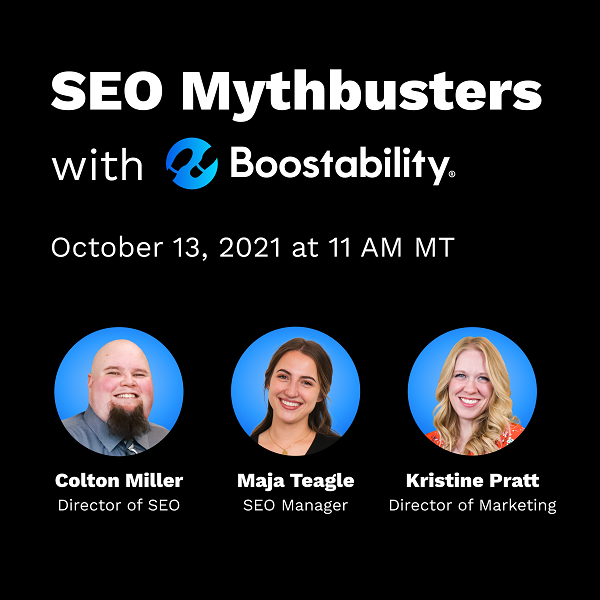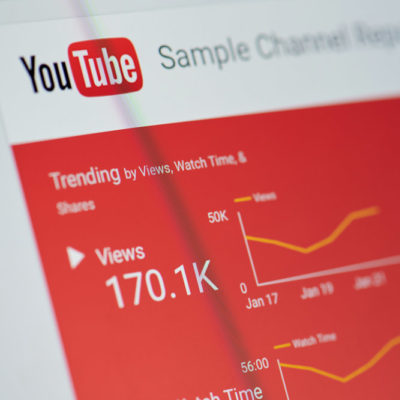It’s time to put these SEO best and worst practice myths to rest! The goal of SEO is to improve your website in the eyes of search engines like Google so your business shows up higher in the results. Simple enough, right? But the world of SEO has in-depth methodology that goes into making a campaign successful. Plus, regular algorithm updates lead to a lot of questions and myths about SEO and it’s processes.
In this month’s edition of Search Sessions, we embraced the spooky season and busted all those SEO myths that haunt your digital marketing success. Boostability’s expert SEO panel of Colton Miller and Maja Teagle answered common SEO questions and myths that simply won’t go away and went into detail on best practices to help build the best SEO strategy for your business.
Make sure to watch our full Search Sessions for all the incredible insights and best practices you need to know to build a successful SEO strategy:
13 SEO Myths
Myth #1 – SEO is Dead
SEO isn’t going anywhere. It will continue to grow and evolve. 67% of first page clicks come from the first 5 organic results. On the first page alone, the first five organic results account for 67.60% of all the clicks. As of 2021, Google accounted for just over 70% of all global desktop search traffic. Additionally, 70% of marketers see SEO as more effective than PPC. This year alone there have been dozens of confirmed and unconfirmed Google algorithm updates, and Google is only going to continue to update their system to make results more relevant to users.
Myth #2 – SEO is a One-Time Thing
SEO is not a one-time thing. SEO never stops because your competition doesn’t stop. It takes approximately 6 months of SEO work to start seeing results and move to the top 10 rankings. But it doesn’t stop there. Depending on your industry and competition, you can see fluctuations and drops. With search standards and factors constantly changing, you need to stay on top of your campaign to remain relevant and competitive. If you’re not keeping up with your SEO, you’re digging yourself into a hole. The more you work on your SEO correctly, the better E-A-T you will have with Google.
SEO never stops because your competition doesn’t stop. #BoostSearchSessions
— Boostability (@Boostability) October 13, 2021
Myth #3 – Search Volume is the Only Thing That Matters
If you’re just getting started in SEO, know that it’s an organic process and takes time to grow. Search volume is good information, but it’s not the key piece to making SEO decisions for your campaign. Search volume is a ‘best guess’ and varies from tool to tool. Volume is meaningless with misaligned SERPs and poor intent match. As we shift more towards the user experience, if your intent is not there you won’t rank on search engines.
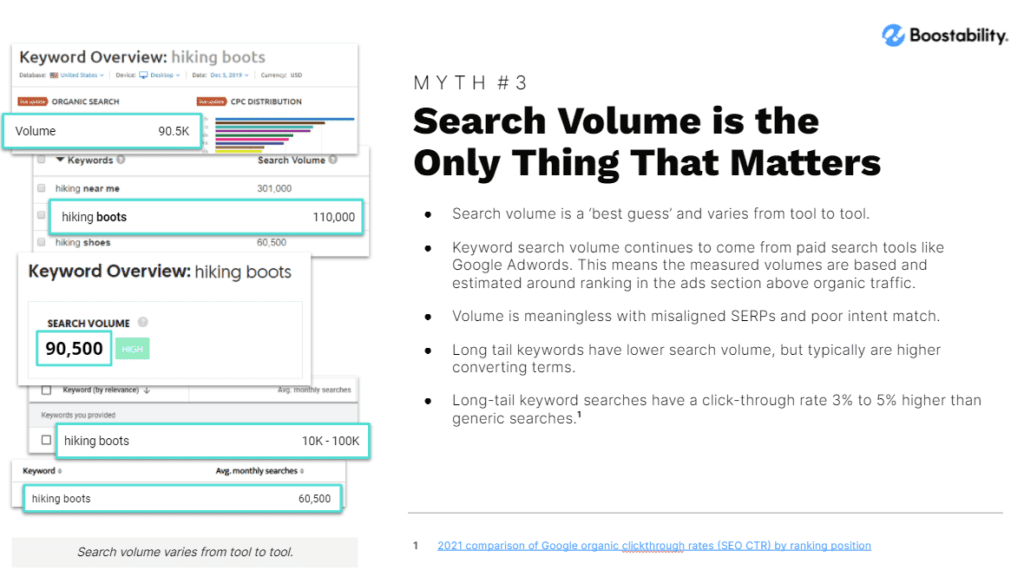
Myth #4 – SEO and Social Media Don’t Impact Each Other
SEO and social media heavily rely and play off of each other. Social media can help get your content in front of an audience that’s more aligned with your business. If you’re sharing great content on your social channels you can increase your chances of exposure and visibility and increase traffic back to your website. This can also increase your chances of obtaining a backlink.
Myth #5 – You Need To Use as Many Keywords as Possible
Avoid keyword stuffing. Keyword semantics and necessity is heavily dependent on known or established relations. Focus on the context and use matter more than term frequency in content. As the algorithm continues to focus on the user experience, Write with your user in mind. Try to make your language as natural and conversational as possible. Instead of stuffing with keywords, add more content for context like tools, reviews, and images.
Myth #6 – All Backlinks are Created Equal
Backlinks are not all created equal. In the past, you wanted to get quantity over quality. But now everything is shifting to relevancy. Domain authority is helpful, but it should not be the only factor you are going after. Rely on relevancy. Vet each backlink. Is it relevant to your business, products, and services? Backlinks give context as to why your content is valuable. You don’t need to always shoot for huge companies. If you’re a small local business, go after high quality, trusted local websites even though they may have a lower domain authority!
Being strategic with your link building can make or break your content strategy, especially if it’s a highly competitive industry or you’re going after highly competitive keywords. The top ranking results on Google typically have 3.8x more backlinks than the pages that are ranking below them. So if you’re asking yourself why your content isn’t ranking even though it’s following all the best practices and Google’s E-A-T for SEO guidelines? Take a look at your backlink status.
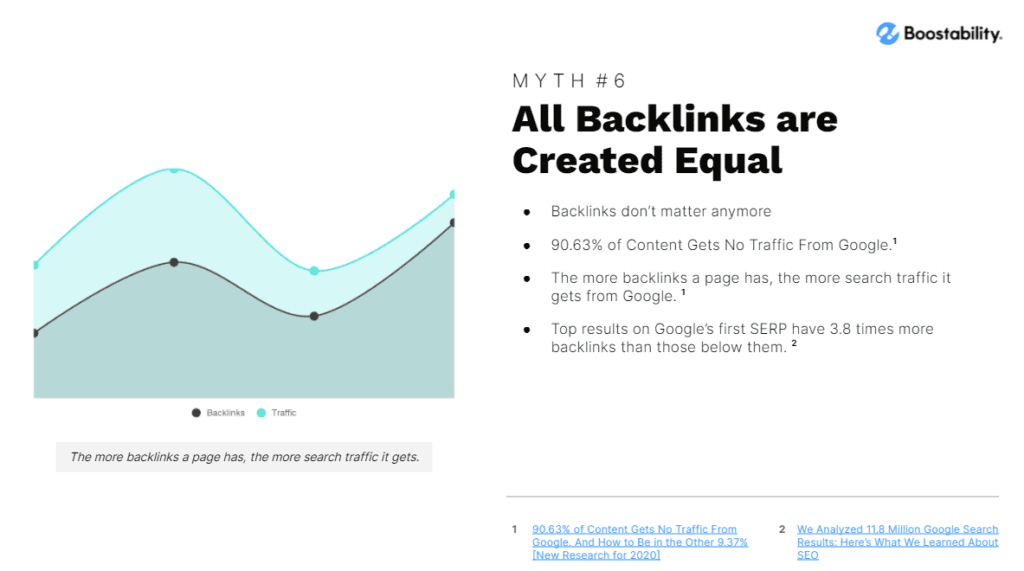
Myth #7 – Domain Authority Only Matters in Backlinking
Domain authority matters, but it’s not the end all to be all. Domain authority is relative and varies per tool. It’s a helpful metric to consider in the overall approach of backlinking, but site relevance and quality are just as important along with other metrics. And it’s important to factor in contextual relevance. Low domain authority websites can still be high quality and highly relevant to your business and customers. They can also generate a lot of traffic, which is another metric to look at as you’re developing your link building strategy because those site visitors can navigate to your website through referral traffic, and can either become a new customer / client or a potential partnership for further business growth.
Myth #8 – Keywords Matter Over Content
While keywords are still important, user experience and content quality are arguably more important, especially with all the algorithm updates focusing on user experience. Your content is the “why.” Why should they stay? Why should they invest in this? Content will always be important in your SEO strategy. It’s what helps to bring users to your site. Keywords are like a lawn sign, while content is like a room/building you go into (which can be amazing, spammy, or barren). Always follow E-A-T best practices.
Myth #9 – Only New Content Ranks on Google
New content is great, but it’s also based in history and trust. Because of that, you need legacy content. If you’re constantly pulling down old content to focus on something new, you are doing yourself a huge disservice. Consider the E-A-T metric. How long has your brand been talking about this subject over the years? Refresh and update your evergreen content to continue to build your authority. Update older content with images and text. Update old outdated stats. Repurpose your content is a big signal to Google for E-A-T because it’s showing your content is providing value to your site visitors.
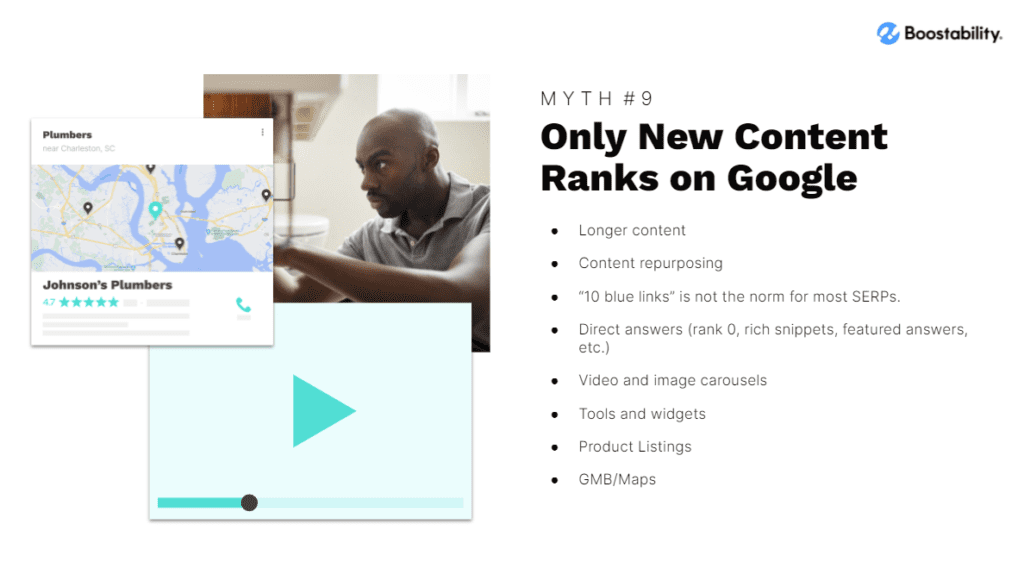
Myth #10 – Accurate Citations are Not a Big Deal
Incorrect listings or inconsistent business information (like NAP – name, address, and phone number) bleeds trust, visits, and conversions. If you have different hours, business info, or contact information, update it! Having your NAP up-to-date and consistent across all directories and listings that your business is featured on is now the standard, not just a best practice. Avoid confusing your current and prospective customers, and make citation maintenance and optimization as part of your monthly routine. And remember to create a profile in the top used directories, like Google My Business, Manta, and Clutch.
There are tools available that can help you accomplish this much faster, as well as help getting your business listed in essential directories and data aggregators. Check out Yext and BrightLocal, two trusted tools in the industry that are used by countless businesses and agencies throughout the nation.
If you have different hours, business info, or contact information, update it! Make it part of your monthly routine. #BoostSearchSessions
— Boostability (@Boostability) October 13, 2021
Myth #11 – Mobile Optimization Doesn’t Matter if Your Target Audience Mostly Uses Desktop
In 2020, 55% of all worldwide website traffic came from mobile. And by 2025, nearly 73% of internet users will access the internet solely via mobile devices. Optimizing for both desktop and mobile is a necessity now. Regardless of how many users you have coming to your site on a desktop, the reality is Google crawls for mobile. When they compare your website to someone else’s, they may rank the other website over yours if they are mobile optimized.
Myth #12 – There’s No Such Thing as Too Many 301 Redirects
Redirects can be a double-edged sword. While Google won’t penalize a website for having too many redirects, you should be strategic with your page creation and removal. Of course, it is best to redirect broken links rather than leaving them as a broken page. But remember, too many redirects can affect user experience. Such as slower site speed, creating redirect chains and loops (if left unoptimized), and can cause a page to be unresponsive resulting in people leaving your website altogether for a competing site.
Myth #13 – SEO is Not For Everyone
SEO is not just for big companies! As long as you have a website and business, you always need to be doing SEO. Continually care for it and build on it. And SEO is not just for your website. It’s everywhere that you’re online. It’s your content, your social, your citations, your aggregator sites and reviews. It’s a core requirement to be considered trustworthy and relevant by consumers.
SEO is not just for big companies! As long as you have a website, you should be doing SEO. You need to always care for it and build on it. It’s a core requirement to be considered trustworthy and relevant by consumers. #BoostSearchSessions pic.twitter.com/ss1negiGX2
— Boostability (@Boostability) October 13, 2021
If you need help with your SEO – Boostability is here to help! Reach out to us at Boostability or give us a call! Also, be sure to check out our next Search Sessions for updates on our next show coming up in November. We’ll post our topic and registration link soon for you to join!

